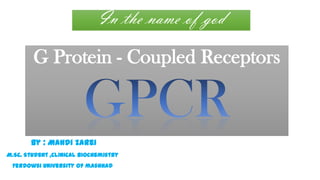
G protein coupled receptor
- 1. In the name of god G Protein - Coupled Receptors by : Mahdi zarei M.Sc. Student ,clinical biochemistry Ferdowsi university of mashhad
- 2. G Protein - Coupled Receptors (GPCRs); GPCRs constitute the largest gene family in the human genome (~950 genes), ~500 of which are sensory. Constitutes > 1% of the human genome. Comprises receptors for a diverse array of molecules: neurotransmitters, odorants, lipids, neuropeptides, large glycoprotein hormones. They are the target of the majority of best-selling drugs (40%-50% of all prescription pharmaceuticals on the market). Examples: • Zyprexa (bipolar disorder & schizophrenia, Eli Lilly) •Zantac (treat and prevent ulcers in the stomach and intestines; histamine receptor antagonists, GlaxoSmithKline)
- 3. Molecular signatures of the GPCR fold ; The structure of a GPCR can be divided into three parts: 1 : the extra-cellular region, consisting of the N terminus and three extracellular loops (ECL1–ECL3); 2 : the TM region, consisting of seven a-helices(TM1–TM7) 3 : the intracellular region, consisting of three intra-cellular loops (ICL1–ICL3), an intracellular amphipathic helix (H8), and the C terminus . In a broad sense, the extracellular region modulates ligand access; the TMregion forms the structural core, binds ligands and transduces this information to the intracellular region through conformational changes, and the intracellular region interfaces with cytosolic signalling proteins.
- 6. Structural and functional hub role of TM3. AJ Venkatakrishnan et al. Nature 494, 185-194 (2013) doi:10.1038/nature11896
- 7. Basic principle of GPCR-mediated signal transduction. Vilardaga J et al. Molecular Endocrinology 2009;23:590-599 ©2009 by Endocrine Society
- 8. Three Main Mammalian GPCR Subfamilies : • Rhodopsin-like group – includes most of the GPCRs.(class A GPCR) • Glucagon-like group.(class B GPCR) • Metabotropic glutamate (mGlu) and GABAB receptor family.(class C GPCR)
- 9. GPCR Ligands Rhodopsin family: amine receptors Acetylcholine (muscarinic) Adrenaline Dopamine Histamine Serotonin Octopamine Trace amine Rhodopsin family: peptide receptors Angiotensin Apelin Bombesin Bradykinin C5a anaphylatoxin CC Chemokine CXC Chemokine CX3C Chemokine C Chemokine Cholecystokinin Endothelin fMet-Leu-Phe Galanin Ghrelin KiSS1-derived peptide Melanocortin Motilin Neuromedin U Neuropeptide FF Neuropeptide S Neuropeptide Y Neuropeptide W / neuropeptide B Neurotensin Orexigenic neuropeptide QRFP Opioid Orexin Oxytocin Prokineticin Somatostatin Tachykinin Urotensin II Rhodopsin family: other receptors Rhodopsin Olfactory Prostaglandin Prostacyclin Thromboxane Adenosine Purine / pyrimidine Cannabinoid Platelet activating factor Gonadotropin-releasing hormone Thyrotropin-releasing hormone Melatonin Lysosphingolipid and LPA (EDG) Leukotriene B4 receptor SREB Mas proto-oncogene & Mas-related (MRGs) RDC1 EBV-induced Relaxin LGR like Free fatty acid G protein-coupled bile acid Nicotinic acid GPR GPR45 like Cysteinyl leukotriene Putative / unclassified Class A GPCRs Secretin family Calcitonin Corticotropin releasing factor Gastric inhibitory peptide Glucagon Growth hormone-releasing hormone Parathyroid hormone PACAP Secretin Vasoactive intestinal polypeptide EMR1 Latrophilin Brain-specific angiogenesis inhibitor (BAI) Methuselah-like proteins (MTH) Cadherin EGF LAG (CELSR) Putative / unclassified Class B GPCRs Metabotropic glutamate family Glutamate (metabotropic) Extracellular calcium-sensing GABA-B Pheromone (V2R) Taste receptors (T1R) Orphan GPRC5 Orphan GPCR6 Bride of sevenless proteins (BOSS) Putative / unclassified Class C GPCRs Other families Frizzled / Smoothened family Ocular albinism proteins Vomeronasal receptors (V1R) Taste receptors (T2R) Insect odorant receptors Nematode chemoreceptors Plant Mlo receptors Fungal pheromone cAMP (Dictyostelium) Bacterial rhodopsin
- 10. Class A Family: The class A GPCR family is referred to as the rhodopsin family. Class A contains the largest number of members compiled into at least 19 subclasses (subfamilies). Class A GPCRs include opsins, the vast majority of the odorant receptors (at least 290 receptors), and receptors for monoamines, purines, opioids, chemokines, some small peptide hormones, and the large glycoprotein hormones that consist of thyroid stimulating hormone (TSH), luteinizing hormone (LH), and follicle-stimulating hormone (FSH).
- 11. Receptor Family 1 – Rhodopsin Family N Y Y C C TM7 TM6 TM5 TM4 TM3 TM2 TM1 Extracellular Lipid Bilayer CC D R Y Intracellular C
- 12. Class B Family: secretin-like receptor class Structurally similar to that of Family 1, except that they have a much larger Nterminal domain, which contains multiple potential S-S bridges. Class B is comprised of 34 subclasses (subfamilies) and members include receptors for peptide hormones or glycoprotein hormones, such as parathyroid hormone (PTH), and calcitonin. The class B family also contains the vast majority of the orphan GPCRs.
- 13. Receptor Family 2 – Glucagon-like Family N Y Y C C TM7 TM6 TM5 TN4 TM3 TM2 TM1 Extracellular Lipid Bilayer CC D R Y Intracellular C
- 14. Class C Family: mGluR/GABAB Family Extremely large extracellular N-terminal ligand binding domain. Shares only ~ 12 % sequence homology with that of Family 1, but the overall transmembrane topology is similar. All Forms dimers ; Metabotropic glutamate receptors dimerization is stabelized by disulfide bonds in the N-terminal extracellular domain. Class C is comprised of 8 subclasses (subfamilies) and members include the metabotropic glutamate receptors (mGluR), extracellular Ca2+-sensing receptors, taste receptors, and several odorant receptors, as well as the pheromone receptors.
- 16. IMMUNITY SYSTEM SIGNALING Leukotrienes ,prostaglandins ,histamin ,c5a complement ,c3a complement ,FMLP bacterial peptide and all chemokain use of GPCR pathway. Members of this family are crucial to immune system function because they also direct responses to anaphylatoxins such as the complement fragment C5a and to many chemokines (chemoattractant peptides and proteins), recruiting phagocytes to sites of infection and promoting inflammation.
- 17. fMLP receptor The fMet-Leu-Phe (fMLP) receptor is a G-protein-coupled receptor that senses the presence of bacteria by recognizing a unique feature of bacte-rial polypeptides. Protein synthesis in bacteria is typically initiated with an N-formylmethionine (fMet) residue, an amino acid present in prokaryotes but not in eukaryotes.
